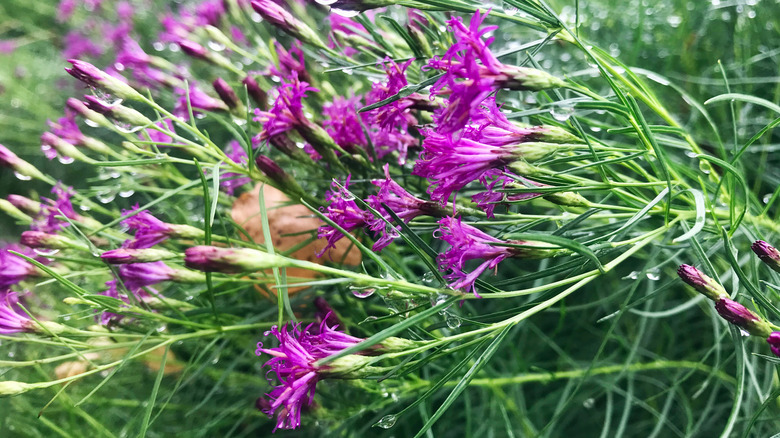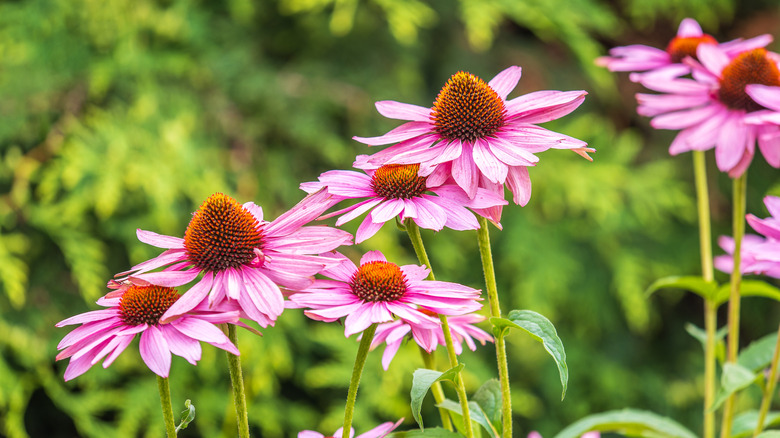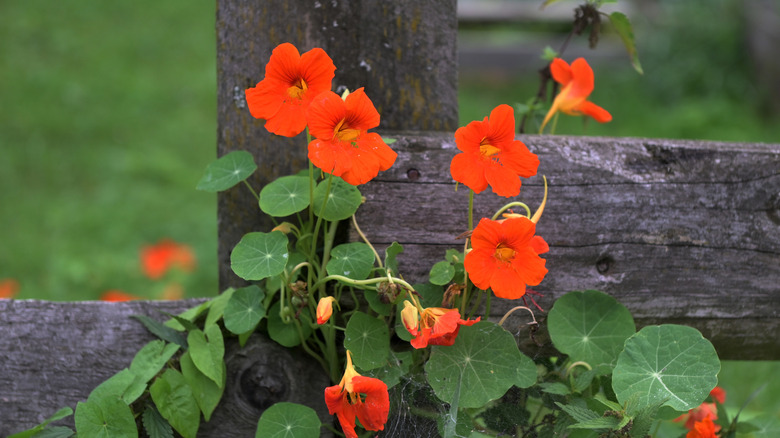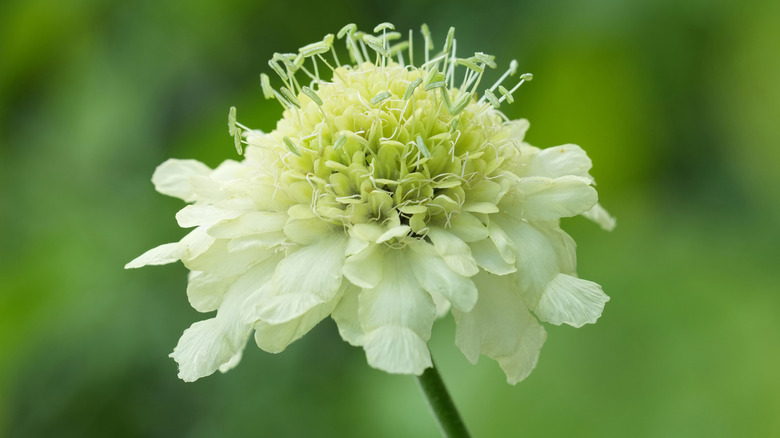11 Plants We Predict Will Be Trending In Gardens For 2026
You've likely just started putting your garden to bed in preparation for winter. But before you transition into your off-season, why not plan ahead for your 2026 garden? Now is the perfect time to plot out the best layout for your garden and even secure seed so you'll be set and ready to plant as soon as the ground thaws out come springtime. If you need inspiration for what to plant next year, we've got you covered. Iron butterfly, milkweed, and purple mullein are just a few plants that we predict will be trending in gardens in the New Year.
Generally speaking, it seems like there are some early themes emerging for the 2026 growing season. For example, it looks like a soft, powdery color palette will be on trend this coming year. However, jewel tones are also set to have a moment. Gardening experts are leaning towards incorporating a range of edible plants while keeping an eye on aesthetics. With a continued awareness of every gardener's role in their local ecosystems, it's apparent that there's a growing push towards working native plants into gardens across the nation.
'Iron Butterfly'
We would be remiss to leave out the 2026 plant of the year on our list of trending plants. The 'Iron Butterfly' (Vernonia lettermannii) is a herbaceous perennial suitable for growing in USDA hardiness zones 4 through 9. This plant is characterized by its fine, feathery foliage and clusters of bright purple, fluffy blooms. With its striking beauty and incredible resilience, it's not hard to understand why the iron butterfly was selected as the 2026 plant of the year. Use this flower in your prairie garden or traditional border for a splash of color.
'Magnus' coneflower
We're already hearing whispers of the next big trend in gardening color schemes for 2026: faded petal pink. It's a soft, blush pink reminiscent of Japanese kusumi colors. With this trend in mind, the 'Magnus' coneflower (Echinacea purpurea 'Magnus') is sure to be popular in the next growing season. Suitable for growing in zones 3 through 8, this plant features blush-purple, daisy-like blooms. Its showy flowers perfectly encapsulate the soft elegance of the faded petal pink trend.
Microgreens
According to a few nursery experts, it looks like edible plants will be all the rage in 2026. But this year, we're leaning away from traditional herbs and embracing microgreens, which are the tender, young shoots of vegetables such as broccoli, radish, or kale. While they're typically grown inside, you can absolutely grow them outside, too. In fact, they're an excellent option if you're working with limited space or are planning a patio garden. As long as you're attentive, it's easy to grow and care for microgreens.
Nasturtiums
Keeping with the theme of edible plants, we predict nasturtiums (Tropaeolum majus) will be on trend in the coming growing season. Not only is this unique flower gorgeous, but all of its aboveground parts are also completely edible — from its blooms down to its seedpods. It can survive the winter in zones 10 through 11, but is grown as an annual in colder regions. To enjoy this plant in your garden, sow seeds directly into the ground 1 to 2 weeks after the last spring frost. In mild regions, you'll find that it will reseed itself year after year.
Scotch bonnet pepper
We're seeing a trend towards unique crops beyond classics such as tomatoes and cucumbers. Scotch bonnets are flavorful hot peppers popular in many Jamaican dishes. This Caribbean pepper is the perfect option for those looking to plant edibles that are a bit outside of the box in 2026. They have a similar spice level to habaneros and carry a sweet, tropical flavor reminiscent of cherries. The scotch bonnet pepper can be yellow, red, or even red-brown. This edible plant generously produces peppers, offering a substantial harvest and a pop of color in your garden.
'ProCut Plum' sunflower
Sunflowers will always have their place in our gardens. But in 2026, we're skipping classic yellow sunflowers and getting more experimental with new, unique cultivars. The 'ProCut Plum' hybrid (Helianthus) grows up to 60 inches tall and features creamy yellow and muted plum blooms. This pollen-less hybrid sunflower ties in beautifully with the faded petal pink trend we talked about earlier. The flowers offer a beautiful spray of color to your outdoor space and serve as great contenders for a cut garden.
Carolina allspice
If ballet slipper pink isn't calling to you, you might want to lean into another trending color scheme taking gardens by storm in 2026 – jewel tones. Carolina allspice (Calycanthus floridus) is a deciduous native shrub found throughout the Southeastern United States. This 10 foot by 12 foot plant features fragrant, burgundy flowers and silvery-green foliage. It's suitable to grow perennially in zones 4 through 9. If you plan to incorporate Carolina allspice in your yard next spring, be sure to select a nursery plant that's already in bloom to confirm that it can produce showy, fragrant flowers.
Giant pincushion flower
While butter yellow has a grip on our design trends lately, you can transfer this to your gardens, too. The giant pincushion flower (Cephalaria gigantea) features muted yellow blooms that can serve as a contrast against other trending colors, such as faded pink and muted jewel tones. This herbaceous perennial is suitable for zones 3 through 7. True to its name, this plant grows up to 6 feet tall and 4 feet across. Be sure to offer it plenty of space in your garden. Luckily, it's a fairly low-maintenance flower to care for.
Milkweed
We're at a point where it's more and more evident that the choices we make in our garden can directly affect our local ecosystem. In lieu of this revelation, gardeners everywhere are embracing keystone plants such as milkweed (Asclepias spp.). A keystone plant is a native plant that plays a vital role in supporting the greater ecosystem. Milkweed is vital for butterfly populations – particularly the monarch butterfly. Not only are milkweeds a beautiful addition to your garden, but they can also help support this threatened species.
'Nightrider' lily
While lilies haven't been on trend in a while, it seems we're ready to embrace them again in 2026. However, we're also leaning towards jaw-dropping, uncommon blooms. The 'Nightrider' lily (Lilium 'Nightrider') is unlike any other flower with its robust purple-black petals. This hybrid is a cross between Asiatic and trumpet lilies. It can grow as tall as 48 inches and blooms from early to mid-summer. You can enjoy this perennial year after year in zones 3 through 9.
Purple mullein
If you're a fan of low-maintenance plants and you're ready to embrace faded petal pink, the purple mullein (Verbascum phoeniceum) might be the perfect option for you. Characterized by its impressive spikes of flowers, mulleins bloom generously from late spring to late summer. There is a wide range of bloom colors to choose from. For that soft, trendy pink, opt for cultivars such as 'Sugar Plum', 'Jackie in Pink', or 'Southern Charm'.











